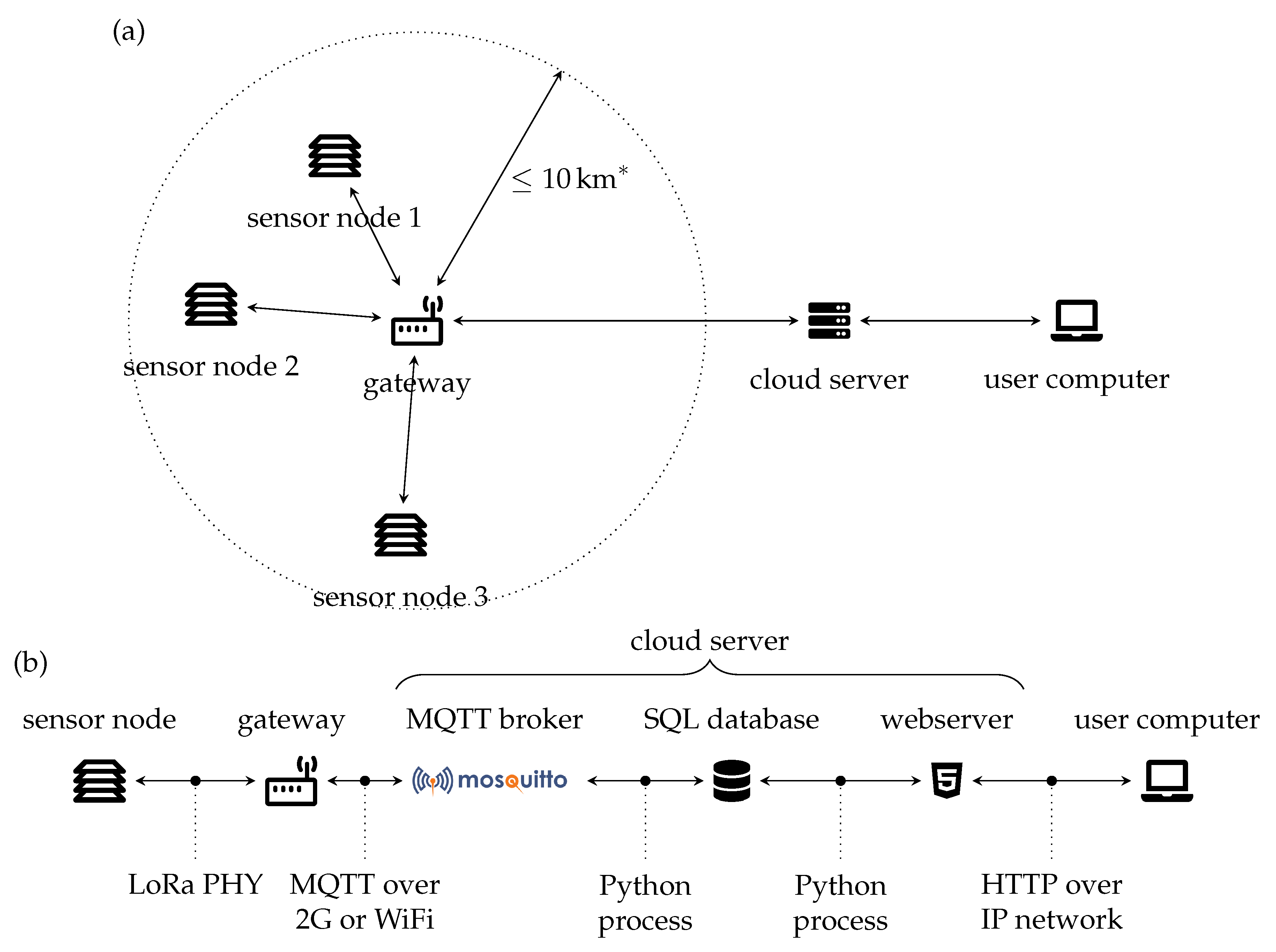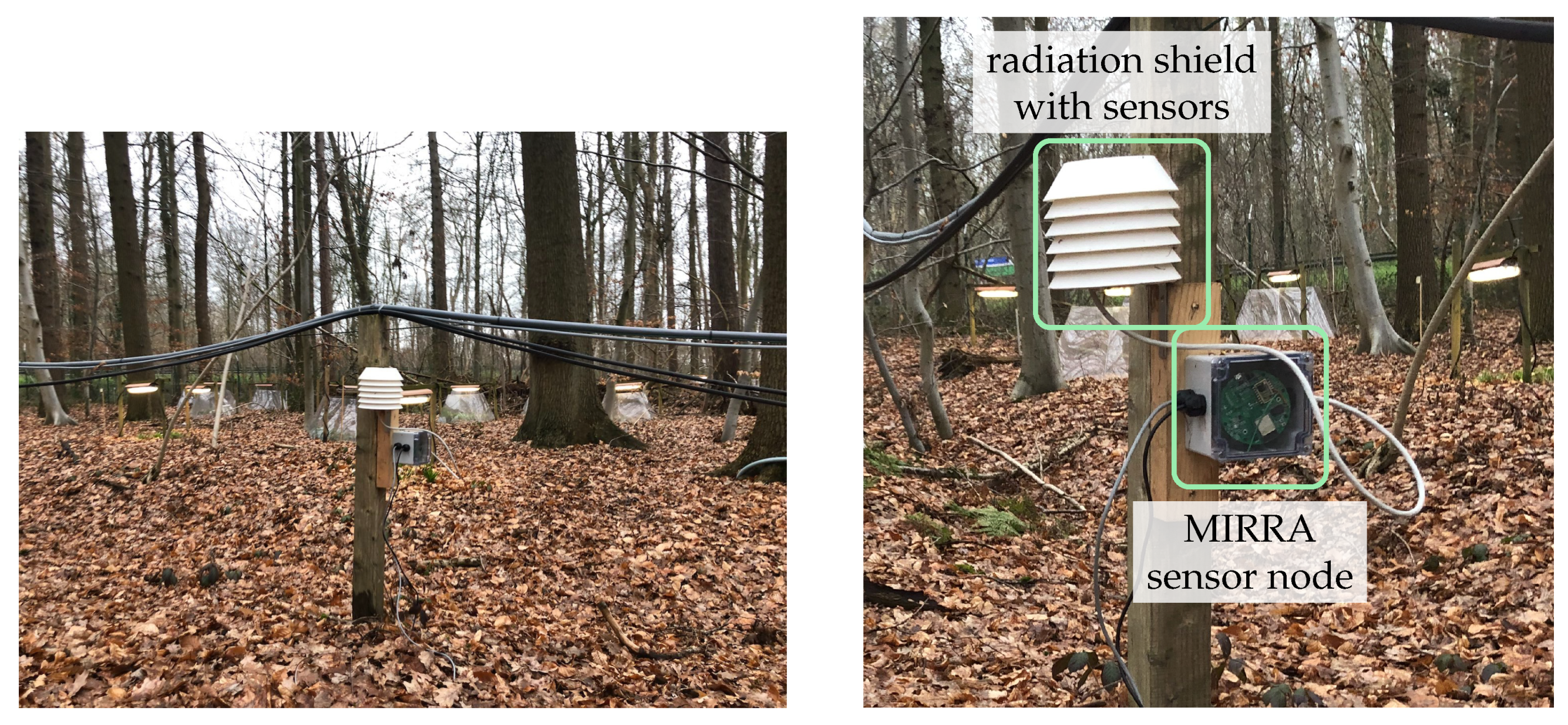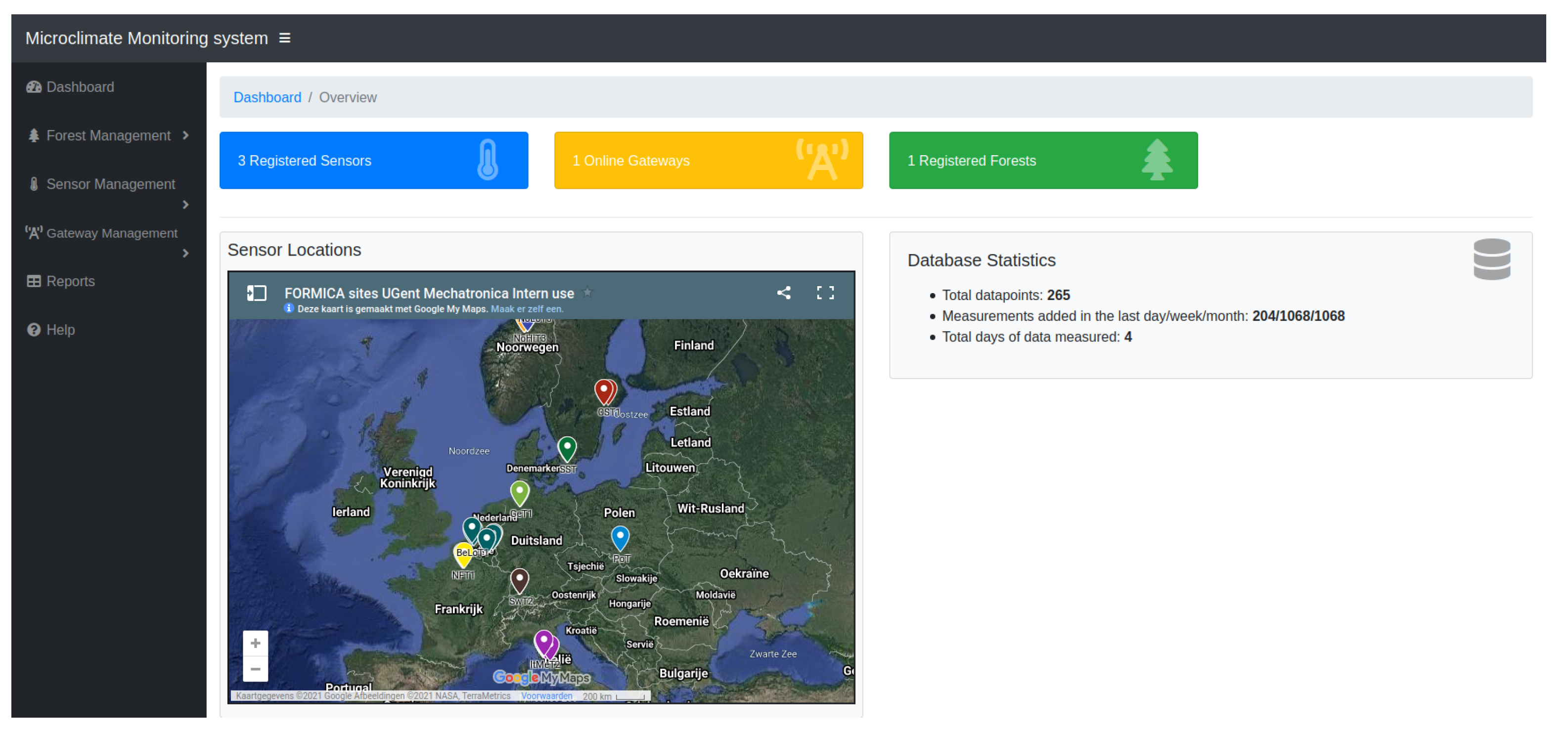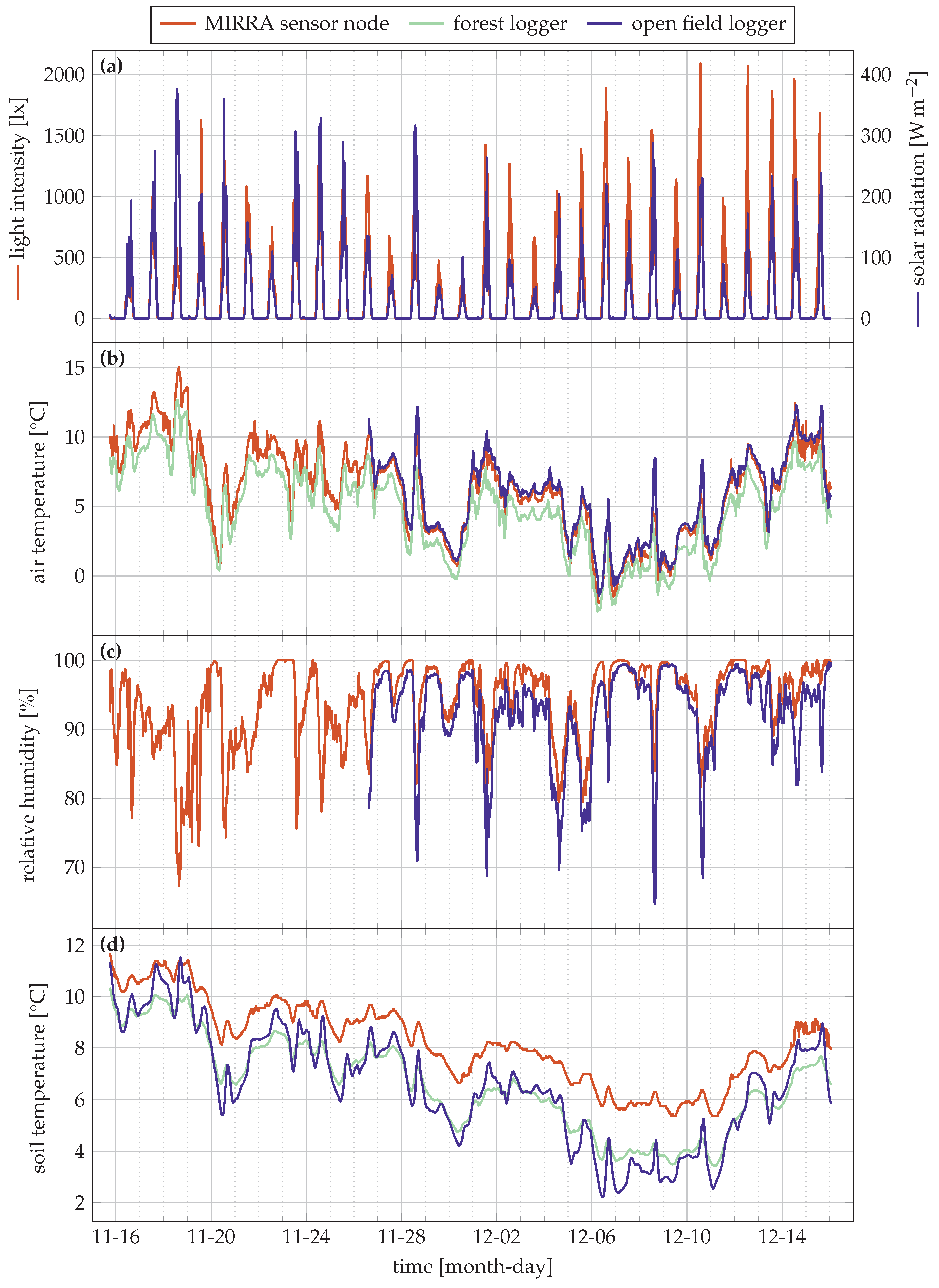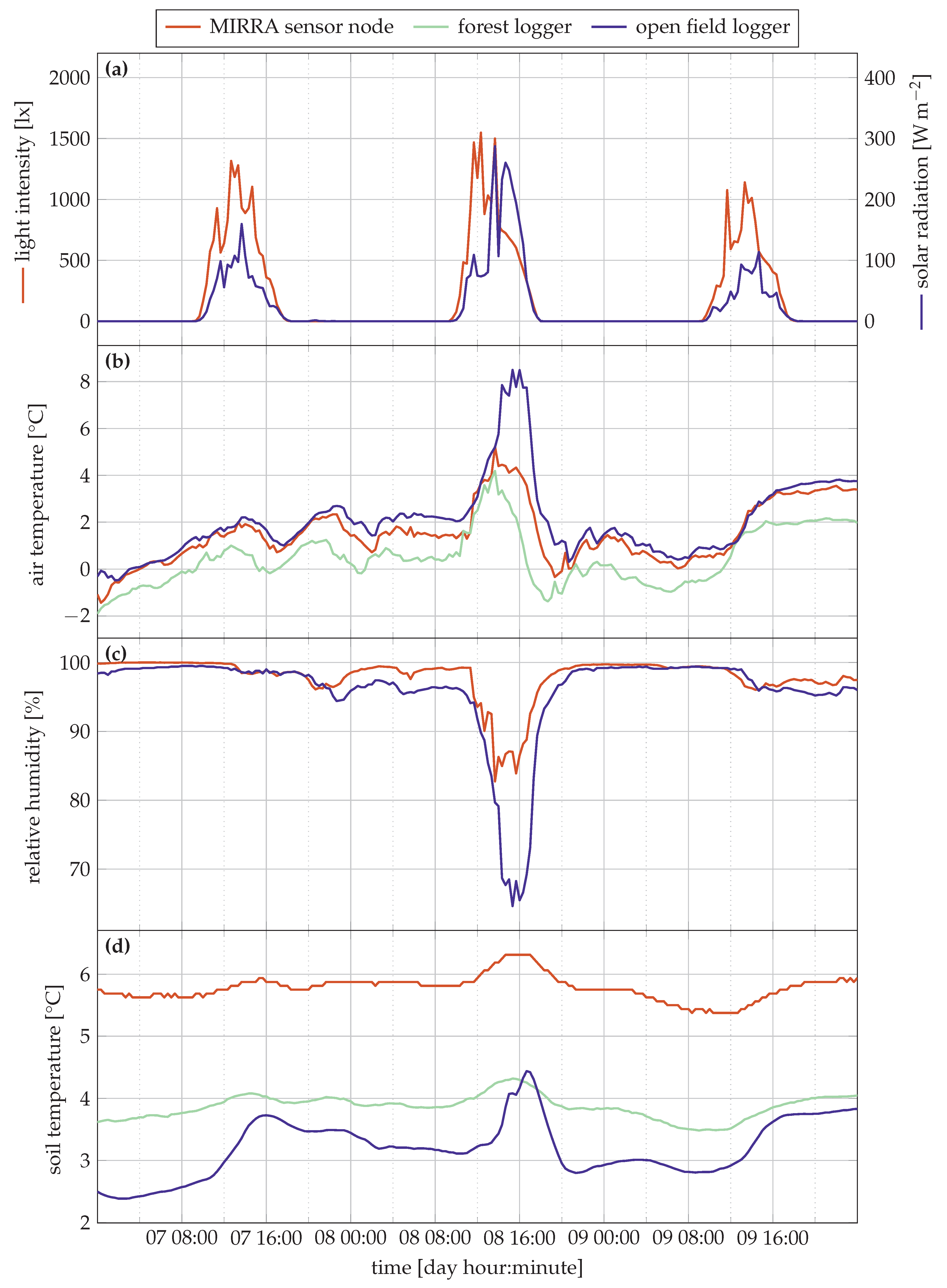In this section, we detail the operating principles and performance of MIRRA, including communication, power consumption, and user interfacing. The entire system is open source and can be constructed and programmed from the design and code files, hosted on GitHub (
https://github.com/opieters/MIRRA, accessed on 7 June 2021) under a permissive Apache 2.0 licence.
2.1. Network Architecture
MIRRA employs a star network, depicted in
Figure 1. A central node, henceforth referred to as gateway, collects the data directly from each sensor node. This design choice simplifies the functionality of nodes and reduces power-requirement of nodes since they do not need to forward messages generated by other nodes. The gateway collects data from all assigned nodes and uploads this data to a server.
Nodes connect to the gateway using a Long Range (LoRa) transceiver. LoRa is a low-power technology that is optimised for long-range optimisation thanks to the usage of sub-gigahertz frequencies, developed by Semtech Corporation (Camarillo, CA, USA) [
20,
21]. In this work, we only rely on simple transmit/receive functionality of the LoRa PHY modulation and do not use the LoRaWAN networking to reduce the overall complexity. Bidirectional communication is implemented to ensure the data is correctly received by the gateway before deletion in the sensor node. To further optimise power consumption, time synchronisation is used. Each node is equipped with a Real-Time Clock (RTC) to awake the system when a communication event occurs and/or sensor data has to be collected. Measurements are performed by all nodes at the same time point, but each node is sequentially contacted by the gateway. Additionally, sensor data from multiple time points is aggregated in a single communication event to reduce power consumption.
The gateway stores all sensor data and uploads it to a central server. Frequent updates are possible, at the expense of increased power consumption, so it is advised to aggregate sensor data before uploading. Data can be uploaded using a 2G (Second Generation) or WiFi (Wireless Fidelity) uplink. A WiFi uplink is convenient and cost-saving if the gateway can be powered from a central supply. For remote operation, the 2G uplink is appropriate. The data is uploaded using the Message Queuing Telemetry Transport (MQTT) protocol.
In our tests, we kept the distance between the sensor node and gateway limited to 100
. This range can be extended using a suitable antenna to multiple kilometres in urban areas and even 15
in rural areas [
22]. The actual range depends on a large number of time- and site-specific conditions such as the weather, surrounding buildings and/or terrain variations.
2.2. Hardware Description, Operating Specifications
An overview of the node’s technical data is provided in
Table 1. MIRRA is designed with microclimate monitoring in mind, even in challenging conditions such as arctic tundra, desert and rainforests. Loggers are able to withstand temperatures as low as
, and as high as 85
. Moreover, MIRRA consumes very little power between measurements. A large Lithium Thionyl Chloride battery of
ensures long on-time without battery replacement. This battery cannot be charged, but if it is drained, it can be replaced by the user. This battery type was preferred over other technologies such as Lithium-Ion (Li-Ion) batteries because of its good performance in cold environments [
23]. Actual lifetime is dependent on the employed sensors, measurement frequency and communication interval.
The gateway has a 2G communication module for the data upload. Because this technology was not optimised for low-power operation, it cannot be powered from the main battery due to too high current peaks. Therefore, a separate 10,000
Li-Ion battery is added. Consequently, communication might be interrupted when the temperature drops below 0
(without data loss). In the future, more power-efficient technologies such as NB-IoT (Narrow-Band Internet of Things) or LTE-M (Long Temp Evolution Machine Type Communication) are possible alternatives.
Table 2 summaries the most important characteristics for battery lifetime computations. Adding additional Lithium Thionyl Chloride batteries to replace the Li-Ion battery was not preferred because this would significantly increase the cost of the gateway.
For a system with a one gateway and one sensor node, we estimate from
Table 1 and
Table 2 that the current battery life for a sensor node is 434 days. For the gateway, the main battery lifetime is approximately 1552 days (using a single
battery). The calculation is detailed in
Appendix A and assumes that three sensors are read out every 20 min. Data are uploaded to the gateway and server on a daily basis. The conditions for this calculation are the same as in the trial (
Section 3). The lifetime of the Li-Ion-battery is approximately 3 years and 6 months (full capacity available). However, the effective capacity of Li-Ion batteries degrades dramatically with decreasing temperature [
24]. As a result, the effective lifetime will be lower and dependent on the weather conditions.
While most experimental designs require air and soil temperature, and relative air humidity logging, additional sensors are sometimes employed to measure specific variables. Examples are wind direction and speed, precipitation, soil moisture content and light intensity [
3]. To optimise flexibility, MIRRA has multiple digital and analogue sensor ports, including three I
2C (Inter-Integrated Circuit), two SPI (Serial Peripheral Interface), two one-wire and two analogue ports. We advise to use digital sensors, since the internal ADC (Analogue-to-Digital Converter) has low performance for high and low voltages. Moreover, digital sensors can also use longer cables without reduced sensitivity. Libraries are implemented for several popular temperature and humidity loggers (e.g., DS18B20, SHT3x).
Sensor data is initially stored in the internal memory of each node. When the gateway is offline, sensor nodes store the sensor values in their 4 flash memory (up to 210,000 sample points for three sensor readouts per time point). Similarly, the gateway retains the data if the central server is offline. As a result, MIRRA can also be deployed without a gateway in situations where offline monitoring of a single location is sufficient and setups without internet uplink.
Due to the need in many experiments to monitor incident light, air temperature and relative humidity, a custom Printed Circuit Board (PCB) and radiation shield were designed. These can easily be interconnected to one of the I
2C ports. The large and open design is optimised for maximum passive air flow. An illustration of a sensor node is depicted in
Figure 2. A Photosynthetically Active Radiation (PAR) sensor, was not used because it would violate the low-cost requirement. To the best of our knowledge, there is no cost-effective PAR sensor available. As a result, we used an alternative sensor (APDS9306, Broadcom Inc., San Jose, CA, USA) that reports light intensity in lux. It is sensitive to wavelengths from 470
to 634
(normalised response higher than 0.1) [
25].
The light sensor in
Figure 2 is covered with a uniform density filter that passes 25% of the available light. This filter was added because in summer, the sensor might otherwise saturate if the gain is incorrectly configured. Direct sunlight corresponds to an intensity of 100,000
to 120,000
[
26], which can cross the maximum value readout value of 1,048,575 (20-bit configuration) when multiplied with the maximal analogue gain value of 18.
